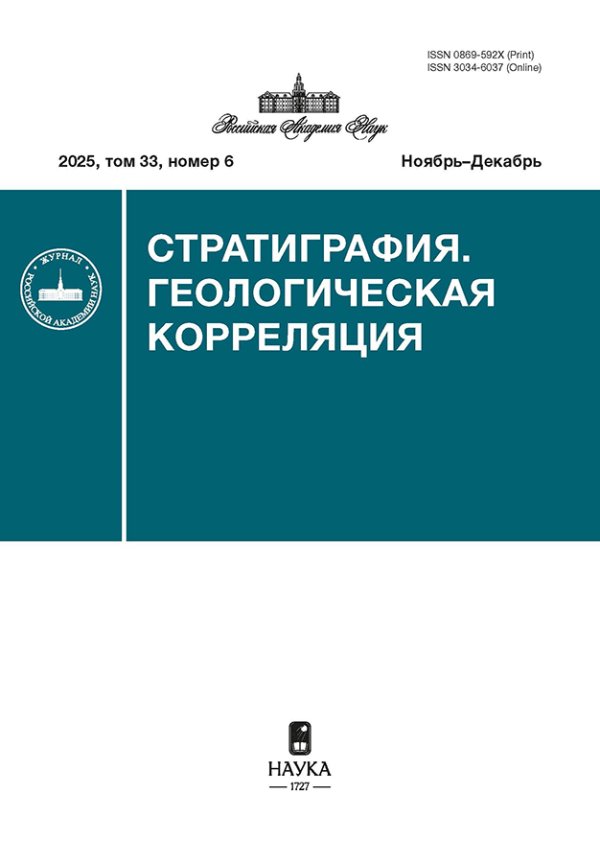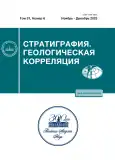The Age and the Accumulation Conditions of the Upper Paleogene–Lower Neogene Kurshskaya Formation Stratotype (Kaliningrad Oblast) by Palynological Data
- Authors: Kuzmina O.B.1, Iakovleva A.I.2, Mychko E.V.3,4, 3,4
-
Affiliations:
- Trofimuk Institute of Petroleum Geology and Geophysics, Siberian Branch of the Russian Academy of Sciences
- Geological Institute, Russian Academy of Sciences
- Shirshov Institute of Oceanology, Russian Academy of Sciences
- Scientific and Education Center “Geoecology and Marine Resource Management”, Immanuel Kant Baltic Federal University
- Issue: Vol 31, No 6 (2023)
- Pages: 140-160
- Section: Articles
- URL: https://journals.rcsi.science/0869-592X/article/view/229426
- DOI: https://doi.org/10.31857/S0869592X23060078
- EDN: https://elibrary.ru/TLBTZY
- ID: 229426
Cite item
Full Text
Abstract
The results of the palinologycal study of the Kurshskaya Formation stratotype (Primorsky quarry, Kaliningrad Oblast) are presented. In the lower part of the Kurshskaya Formation (Member of “chocolate” clays), a complex of dinoflagellate cysts with Areosphaeridium diktyoplokum, Glaphyrocysta semitecta, and Cordosphaeridium funiculatum of latest Eocene age was found. The formation is characterized by four spore-pollen assemblages: (1) Pinuspollenites–Inaperturopollenites–Sciadopityspollenites assemblage of latest Eocene age in the “chocolate” clays and in the lower part of brown sands; (2) Sequoiapollenites–Betulaepollenites betuloides assemblage of early Oligocene age in the lower part of the brown sands member; (3) Boehlensipollis hohli–Carpinipites carpinoides assemblage of early Oligocene age in the middle part of brown sands member; (4) Alnipollenites–Corylopollis assemblage of late Oligocene–early Miocene age in the upper part of the brown sands of the Kurshskaya Formation. The general age of the Kurshskaya Formation is terminal Eocene–early Miocene. In the lower parts of the Zamland Formation, which overlies the Kurshskaya Formation, the Pinuspollenites–Tricolporopollenites pseudocingulum–T. euphorii assemblage presumably of middle Miocene age was found. Based on the obtained palynological data, the conditions of sedimentation at the end of the Eocene–Oligocene–early Miocene in the South Baltic region are reconstructed. The regression of the sea basin began as early as the end of the Priabonian, the climate was still quite warm and humid, close to subtropical. Mesophytic mixed coniferous-broad-leaved forests grew along the shores of the strait, low-lying areas of land were occupied by marsh vegetation. Cooling at the Eocene/Oligocene boundary resulted in the appearance of hemlock in plant communities and an increase in the proportion of catkins (alder, birch, hornbeam). Presumably, in the late Oligocene–early Miocene, the proportion of small-leaved trees, especially alder and hazel, sharply increased in mesophytic forests, while the number of pine trees decreased. Wetter and warmer climatic conditions are assumed for the early Miocene: this time is characterized by an increase in the number of walnut, cypress, and Cyrillaceae. In the middle Miocene, the climate was still quite warm, but drier, and such moisture-loving species as podocarpus, spruce, glyptostrobus, and swamp cypress disappeared from plant communities.
About the authors
O. B. Kuzmina
Trofimuk Institute of Petroleum Geology and Geophysics, Siberian Branch of the Russian Academy of Sciences
Author for correspondence.
Email: KuzminaOB@ipgg.sbras.ru
Russian Federation, Novosibirsk
A. I. Iakovleva
Geological Institute, Russian Academy of Sciences
Email: KuzminaOB@ipgg.sbras.ru
Russian Federation, Moscow
E. V. Mychko
Shirshov Institute of Oceanology, Russian Academy of Sciences; Scientific and Education Center “Geoecology and Marine Resource Management”, Immanuel Kant Baltic Federal University
Email: KuzminaOB@ipgg.sbras.ru
Russian Federation, Moscow; Russian Federation, Kaliningrad
Email: KuzminaOB@ipgg.sbras.ru
References
- Ахметьев М.А. Стратиграфия и флора позднего кайнозоя Исландии. М.: Наука, 1978. 188 с. (Тр. ГИН РАН СССР. Вып. 316).
- Ахметьев М.А., Александрова Г.Н., Беньямовский В.Н., Васильева О.Н., Железко В.И., Запорожец Н.И. Курганские слои нижнего олигоцена Западной Сибири и Зауралья // Стратиграфия. Геол. корреляция. 2001. Т. 9. № 4. С. 65–79.
- Балтакис В.И. Осадочные формации и литологические комплексы палеогена и неогена Южной Прибалтики // Литология и геология полезных ископаемых Южной Прибалтики. Тр. Института геологии (Вильнюс). 1966. Вып. 3. С. 277–323.
- Буданцев Л.И., Свешникова И.Н. Третичная флора Калининградского полуострова. Ч. IV // Тр. Ботанического института АН СССР. 1964. Сер. 8. Палеоботаника. № 5. С. 83–112.
- Веножинскене А.И. Палинологические комплексы палеогена Южной Прибалтики // Мезозой и кайнозой Южной Прибалтики и Белоруссии. Научн. сообщ. Ин-та геологии и географии АН ЛитССР, 1960. Т. 12. С. 41–47.
- Геологические и биотические события позднего эоцена–раннего олигоцена на территории бывшего СССР. Ч. I. Региональная геология верхнего эоцена и нижнего олигоцена. Отв. ред. Крашенинников В.А., Ахметьев М.А. М.: ГЕОС, 1996. 314 с. (Тр. ГИН РАН. Вып. 489).
- Запорожец Н.И. Палиностратиграфия и зональное расчленение по диноцистам среднеэоценовых–нижнемиоценовых отложений р. Белой (Северный Кавказ) // Стратиграфия. Геол. корреляция. 1999. Т. 7. № 2. С. 61–78.
- Запорожец Н.И., Ахметьев М.А. Палеоботаническое изучение разреза майкопской серии олигоцена–нижнего миоцена по р. Белая выше г. Майкопа, Предкавказье // Стратиграфия. Геол. корреляция. 2017. Т. 25. № 6. С. 61–83.
- Зосимович В.Ю. Граница олигоцена и миоцена в бореальной провинции Восточно-Европейской платформы // Геол. журн. (Киев). 1991. № 3. С. 89–98.
- Зосимович В.Ю., Шевченко Т.В. Палеогенові відклади Північноукраїнської палеоседиментаційної провінції // Палеоокеанографія та палеоседиментогенез. Збiрник наукових праць Iнституту геологiчних наук НАН Украïни. 2015. Т. 8. С. 68–121.
- Кузьмина О.Б., Яковлева А.И. Новые данные о спорово-пыльцевой характеристике верхнеэоценовых отложений Самбийского полуострова, Калининградская область // Стратиграфия. Геол. корреляция. 2023. Т. 31. № 3. С. 99–115.
- Мурашко Л.И., Рылова Т.Б., Якубовская Т.В. Поздний олигоцен Беларуси // Стратиграфия. Геол. корреляция. 1998. Т. 6. № 4. С. 67–80.
- Практическая палиностратиграфия. Ред. Панова Л.А., Ошуркова М.В., Романовская Г.М. Л.: Недра, 1990. 348 с.
- Стотланд А.Б. Микрофитофоссилии позднего эоцена–среднего миоцена Днепровско-Донецкой впадины и их стратиграфическое значение. Автореф. дисс. … канд. геол.-мин. наук. Киев, 1984. 26 с.
- Стотланд А.Б. Корреляция олигоценовых отложений Днепровско-Донецкой впадины по динофлагеллатам // Актуальные вопросы современной палеоальгологии. Киев: Наук. думка, 1986. С. 60–65.
- Стратиграфические схемы докембрийских и фанерозойских отложений Беларуси. Объяснительная записка. Минск: БелНИГРИ, 2010. 282 с.
- Харин Г.С., Лукашина Н.П. Условия образования и корреляция янтареносной прусской свиты (верхний эоцен, Калининградская область) // Стратиграфия. Геол. корреляция. 2002. Т. 10. № 2. С. 93–99.
- Яковлева А.И. Детализация эоценовой диноцистовой шкалы для восточного Перитетиса // Бюлл. Моск. о-ва испытателей природы. Отд. геол. 2017. Т. 92. Вып. 2. С. 32–48.
- Akkiraz M.S., Akgün F. Palynology and age of the Early Oligocene units in Cardak-Tokca basin, southwest Anatolia: paleoecological implications // Geobios. 2005. V. 38. P. 283–299.
- Akkiraz M.S., Akgün F., Örçen S. Stratigraphy and palaeoenvironment of the Lower–“middle” Oligocene units in the northern part of the Western Taurides (Incesu area, Isparta, Turkey) // J. Asian Earth Sci. 2011. V. 40. P. 452–474.
- Boulter M.C., Craig D.L. A middle Oligocene pollen and spore assemblage from the Bristol channel // Rev. Paleobot. Palynol. 1979. V. 28. P. 259–272.
- Brinkhuis H. Late Eocene to early Oligocene dinoflagellate cysts from the Priabonian type-area (Northeast Italy): biostratigraphy and paleoenvironmental interpretation // Palaeogeogr. Palaeoclimatol. Palaeoecol. 1994. V. 107 (1–2). P. 121–163.
- Brinkhuis H., Biffi U. Dinoflagellate cyst stratigraphy of the Eocene/Oligocene transition in central Italy // Marine Micropaleontol. 1993. V. 22. P. 131–183.
- Châteauneuf J.J. Evolution of the microflora and dinocysts at the Eocene–Oligocene boundary in Western Europe // Terminal Eocene events. Eds. Pomerol C., Premoli-Silva I. Amsterdam: Elsevier Science Publishers B.V., 1986. P. 289–292.
- Egger L.M., Sliwinska K.K., Van Peer T.E., Liebrand D., Lippert P.C., Friedrich O., Wilson P.A., Norris R.D., Pross J. Magnetostratigraphically-calibrated dinoflagellate cyst bioevents for the uppermost Eocene to lowermost Miocene of the western North Atlantic (IODP Expedition 342, Paleogene Newfoundland sediment drifts) // Rev. Palaeobot. Palynol. 2016. V. 234. P. 159–185.
- Gedl P. Dinoflagellate cyst record of the Eocene–Oligocene boundary succession in flysch deposits at Leluchow, Carpathian Mountains, Poland // Geol. Soc. London. Spec. Publ. 2004. V. 230 (1). P. 309–324.
- Gedl P., Worobiec E., Słodkowska B. Palynology of Lower Oligocene brown coal and lower most Middle Miocene sand deposits from the Łukowa-4 borehole (Carpathian Foredeep, SE Po land) – implications for palaeogeographical reconstructions // Geol. Quart. 2016. V. 60 (4). P. 943–958.
- Göppert H.R., Berendt G.C. Der Bernstein und die in ihm befindlichen Pflanzenreste der Vorwelt. Berlin, 1845. 126 p.
- Heilmann-Clausen C., Van Simaeys S. Dinoflagellate cysts from the Middle Eocene to ?Lowermost Oligocene succession in the Kysing Research borehole, central Danish Basin // Palynology. 2005. V. 29 (1). P. 143–204.
- Hochuli P.A. Palynologische untersuchungen im Oligosen der zentralen und westlichen Paratethys // Beitrrage Palaontologie. 1978. Osterreich. V. 4. P. 1–132.
- Iakovleva A.I., Aleksandrova G.N., Mychko E.V. Late Eocene (Priabonian) dinoflagellate cysts from Primorsky quarry, southeast Baltic coast, Kaliningrad Oblast, Russia // Palynology. 2021. https://doi.org/10.1080/01916122.2021.1980743
- Kosmowska-Ceranowisz B., Müller C. Lithology and calcareous nannoplankton in amberbearing Tertiary sediments from boreholes Chlapovo // Bull. Ac. Pol. Terre. 1985. V. 33. P. 119–129.
- Nickel B. Palynofazies und Palynostratigraphie der Pechelbronner Schichten im nordlichen Oberrheintalgraben // Palaeontographica. 1996. Abteilung B. Ionnides 240. P. 1–151.
- Piwocki M. Paleogen // Budowa geologiczna Polski, 1: stratygrafia, 3a: kenozoik, paleogen, neogen. Eds. Peryt T.M., Piwocki M. Warszawa: Pañstwowy Instytut Geologiczny, 2004. P. 22–71 (in Polish).
- Piwocki M., Ziembinska-Tworzydło M. Neogene of the Pollish Lowlands – lithostratigraphy and pollen-spore zones // Geol. Quart. 1997. V. 41. № 1. P. 21–40.
- Schweigger A.F. Beobachtungen auf naturhistorischen Reisen. Berlin, 1819. 130 p.
- Słodkowska B. Palynological studies of the Paleogene and Neogene deposits from the Pomeranian Lakeland Area (NW Poland) // Polish Geol. Instit. Spec. Pap. 2004. № 14. P. 1–116.
- Słodkowska B. Palynology of the Paleogene and Neogene from the Warmia and Mazuri areas (NE Poland) // Geologos. 2009. V. 15. № 3–4. P. 219–234.
- Thomas K. Die Bernsteinformation des Samlandes // Preußische Provinzial-Blätter. 1847. Bd. 3. P. 241–245.
- Von Heer O. Miocene Baltische Flora // Beiträge zur Naturkunde Preussens. Königlichen physikalisch-öconomischen Gesellschaft zu Königsberg. Königsberg, 1869. 104 p.
- Zaddach G. Űber die Bernstein- und Braunkohlenlager des Samlandes // Schriften der Physikalisch-Ökonomischen Gesellschaft zu Königsberg in Pr. 1860. Jg. 1. P. 1–44.
- Zaddach G. Das Tertiärgebirge des Samlandes // Schriften der Physikalisch-Ökonomischen Gesellschaft zu Königsberg in Pr. 1868. J. 8. P. 85–197.
Supplementary files




















